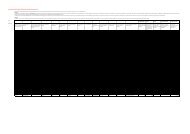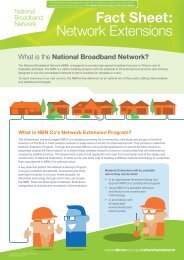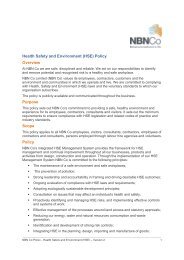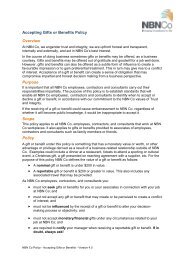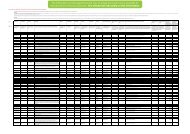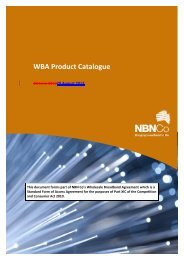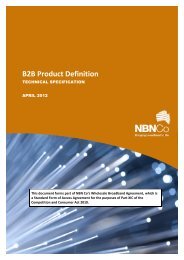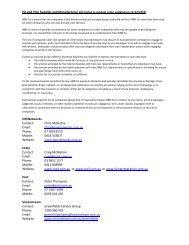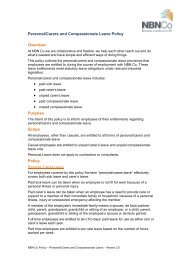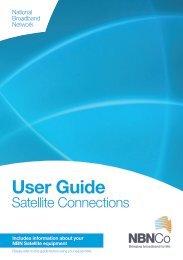NBN Co Network Design Rules
NBN Co Network Design Rules
NBN Co Network Design Rules
You also want an ePaper? Increase the reach of your titles
YUMPU automatically turns print PDFs into web optimized ePapers that Google loves.
<strong>NBN</strong> <strong>Co</strong> <strong>Network</strong> <strong>Design</strong> <strong>Rules</strong><br />
1.1.19.1. Reconfigurable Optical Add-Drop Multiplexers (ROADMs)<br />
Reconfigurable Optical Add-Drop Multiplexers (ROADMs): these are one- (or more) degree nodes<br />
that can provide the following functions:<br />
<br />
<br />
<br />
Extract data from a wavelength on any of its degrees for presentation to a client<br />
interface<br />
Inject data from the client interface into a wavelength for transport on any of its degrees<br />
Transit wavelengths between degrees<br />
The standard ROADM variant used allows transmission up to 96 wavelengths, each wavelength in<br />
effect a channel of 40Gbps initially, rising to 100Gbps in future network releases. Standard ROADMs<br />
will be used at both POI and FAN sites.<br />
A smaller, compact ROADM variant, for use where space is an issue, supports up to 8 wavelengths.<br />
The standard and compact ROADMs can be used together: although the compact ROADM only<br />
supports 8 wavelengths, those wavelengths can be any of the 96 produced by the standard ROADM.<br />
<strong>Co</strong>mpact ROADMs will be used only at FAN sites that require a maximum of two degrees and a<br />
maximum of 8 channels.<br />
There is also a Long Span ROADM that is used to allow un-regenerated OMS links across Bass Strait.<br />
The Long Span ROADM allows up to 40 wavelengths (channels).<br />
1.1.19.2. Optical Line Repeaters (OLRs)<br />
Optical Line Repeaters (OLRs): these are two-degree wavelength-pass-through nodes that provide<br />
optical amplification only. OLRs may be required when transmission fibre distances between<br />
adjacent ROADMs exceeds the optical reach of the equipment.<br />
1.1.19.3. DWDM <strong>Network</strong> Topologies<br />
There are four network topologies that can be deployed. In most cases the overlapping physical ring<br />
topology will be used as the majority of dark fibre is being sourced from Telstra and only a single pair<br />
is being provided on most routes.<br />
Standalone Physical Rings:<br />
Each physical ring utilises one fibre pair. Wavelength routing and count within one ring has no<br />
dependencies on the physical attributes or traffic requirements on any other ring. If there are any<br />
DNs common between rings, they will require a degree of more than two. Any inter-ring wavelength<br />
connectivity will be performed via the wavelength selective switches within the common DNs.<br />
32



